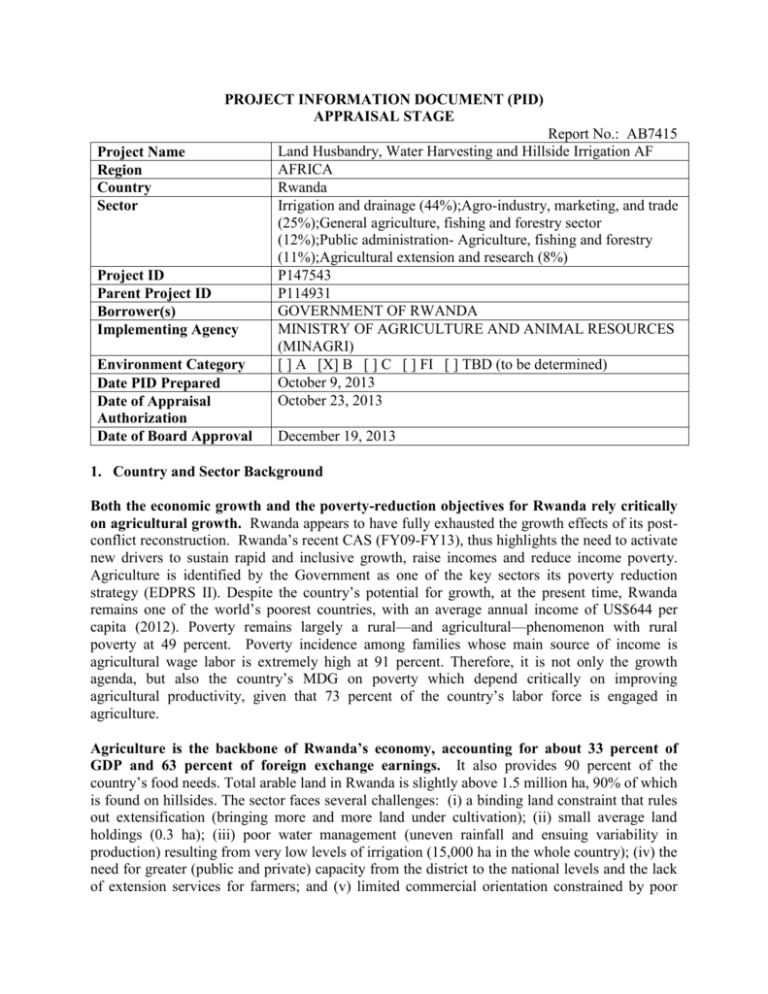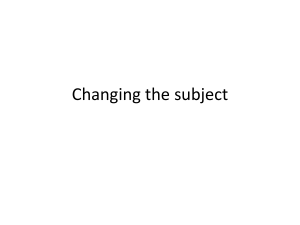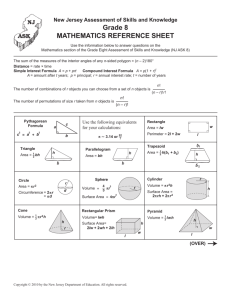Project Name - Documents & Reports
advertisement

PROJECT INFORMATION DOCUMENT (PID) APPRAISAL STAGE Project Name Region Country Sector Project ID Parent Project ID Borrower(s) Implementing Agency Environment Category Date PID Prepared Date of Appraisal Authorization Date of Board Approval Report No.: AB7415 Land Husbandry, Water Harvesting and Hillside Irrigation AF AFRICA Rwanda Irrigation and drainage (44%);Agro-industry, marketing, and trade (25%);General agriculture, fishing and forestry sector (12%);Public administration- Agriculture, fishing and forestry (11%);Agricultural extension and research (8%) P147543 P114931 GOVERNMENT OF RWANDA MINISTRY OF AGRICULTURE AND ANIMAL RESOURCES (MINAGRI) [ ] A [X] B [ ] C [ ] FI [ ] TBD (to be determined) October 9, 2013 October 23, 2013 December 19, 2013 1. Country and Sector Background Both the economic growth and the poverty-reduction objectives for Rwanda rely critically on agricultural growth. Rwanda appears to have fully exhausted the growth effects of its postconflict reconstruction. Rwanda’s recent CAS (FY09-FY13), thus highlights the need to activate new drivers to sustain rapid and inclusive growth, raise incomes and reduce income poverty. Agriculture is identified by the Government as one of the key sectors its poverty reduction strategy (EDPRS II). Despite the country’s potential for growth, at the present time, Rwanda remains one of the world’s poorest countries, with an average annual income of US$644 per capita (2012). Poverty remains largely a rural—and agricultural—phenomenon with rural poverty at 49 percent. Poverty incidence among families whose main source of income is agricultural wage labor is extremely high at 91 percent. Therefore, it is not only the growth agenda, but also the country’s MDG on poverty which depend critically on improving agricultural productivity, given that 73 percent of the country’s labor force is engaged in agriculture. Agriculture is the backbone of Rwanda’s economy, accounting for about 33 percent of GDP and 63 percent of foreign exchange earnings. It also provides 90 percent of the country’s food needs. Total arable land in Rwanda is slightly above 1.5 million ha, 90% of which is found on hillsides. The sector faces several challenges: (i) a binding land constraint that rules out extensification (bringing more and more land under cultivation); (ii) small average land holdings (0.3 ha); (iii) poor water management (uneven rainfall and ensuing variability in production) resulting from very low levels of irrigation (15,000 ha in the whole country); (iv) the need for greater (public and private) capacity from the district to the national levels and the lack of extension services for farmers; and (v) limited commercial orientation constrained by poor access to output and financial markets. Without the option of extensification, agricultural intensification must take place in the context of a potentially fertile, but challenging, physical environment. Steep terrains and the highest population density in sub-Saharan Africa (416 inhabitants per km²) make good land husbandry a strict necessity (to curtail erosion and otherwise maintain the quality of the soil), as well as an environmental prerogative. Arable land on hillsides constitutes the vast majority of the total agricultural land in the country, but erosion costs the country 4 million tons of fertile soils per year. Given its high dependence on rain fed agriculture, irrigation is critical to reducing the sector’s vulnerability to climatic variation and to aligning the right incentives for intensification. 2. Objectives No change to the existing Project Development Objective (PDO). The PDO of the parent Project is to increase the productivity and commercialization of hillside agriculture in target areas. Specifically, the key outcome indicators for the project objective are proposed as follows: (i) increase in productivity of targeted irrigated command areas ($/ha); (ii) increase in productivity of targeted non-irrigated command areas ($/ha); and (iii) increased share in commercialized products from targeted areas. 3. Rationale for Bank Involvement The LWH Project provides the opportunity to address some of the fundamental constraints to agricultural growth in Rwanda, listed above. As such, it has proved its potential to be truly transformational in its scope. The rationale for Bank involvement in the proposed Project is underpinned by: (i) the Bank’s own strong experience and expertise in agricultural intensification (within and without Rwanda) and in successful watershed management approach to hillside rehabilitation (The Loess Plateau in China, LWH in Rwanda); (ii) a strong commitment and ownership of the Rwandan authorities of the project; and (iii) the specific request from the Government for Bank support. The Bank’s involvement in LWH has since catalyzed support from numerous other development partners including the Global Agriculture and Food Security Program (GAFSP), United State Agency for International Development (USAID), Canadian International Development Agency (CIDA), and other donors have shown interest. 4. Description The Land Husbandry, Water Harvesting and Hillside Irrigation (LWH) Project uses a modified watershed approach to introduce sustainable land husbandry measures for hillside agriculture on selected sites, as well as developing hillside irrigation for sub-sections of sites where feasible. The Project envisions the production of high-valued horticultural crops with the strongest marketing potential on irrigated portions of hillsides, and the improved productivity and commercialization of rainfed crops on the rest (the majority) of the site catchment-area hillsides. The LWH represents a transformation of hillside intensification with a view to increasing productivity in an environmentally sustainable manner. The LWH Project therefore has three components: (A) developing the human and organizational capacity; (B) provision of the required physical infrastructure for hillside intensification and transformation; and (C) SWAp project management. Component A: Capacity Development and Institutional Strengthening for Hillside Intensification The objective of Component A is to develop the capacity of individuals and institutions for improved hillside land husbandry, stronger agricultural value chains and expanded access to finance. Component B: Infrastructure for Hillside Intensification The objective of this component is to provide the essential ‘hardware’ for hillside intensification to accompany the capacity development and institutional strengthening activities of Component A. Component C: Implementation through the Ministerial SWAp Structure The objective of Component C is to ensure that Project activities are effectively managed within the new ‘SWAp structure’ for Ministerial implementation of programs and projects at MINAGRI. This structure is composed of 4 Single projects implementation Units (SPIUs). 5. Financing Source: BORROWER/RECIPIENT International Development Association (IDA) Total ($m.) 0 35 35 6. Implementation The LWH will be implemented the Single Project Implementation Unit (SPIU). This SPIU which coordinates all World Bank funded projects in MINAGRI has been effectively in place for the last two years and was a result of a gradual merger of the former Rural Sector Support Project (RSSP) and LWH Project Implementation Units (PIUs). An inter-ministerial steering committee (ISC) oversees project implementation and provides strategic orientation and guidance to the SPIU. The ISC meets on quarterly basis and is chaired by the Permanent Secretary of MINAGRI. For the proposed Additional Financing the implementation arrangements will utilize the same as those for the parent LWH. LWH implementation happens at the National and District levels. The National level coordinates and has strong management, technical and fiduciary (FM and Procurement) teams while the district level comprises of the technical implementation teams which coordinate both project activities on sites within one or across two adjacent districts. As per the normal implementation procedures of an IPF, the PM will refer to the Bank for support for procurement and financial management functions in implementation (i.e. no objections, etc.). 7. Sustainability Government ownership for the LWH is high. The original conception and design of the LWH was the Government’s and the subsequent design modifications (e.g. inclusion of marketing activities, participatory processes, etc.) were developed in full discussion and partnership with MINAGRI and its specialists. As a consequence, the Project, its activities, and its outputs are de facto, perfectly aligned with the Government’s strategy and objectives for hillside intensification. In brief, the sustainability of the LWH is ensured by the Government’s commitment to its own program and strategy and this strategy has been adhered to for the last three years of the parent LWH implementation. Bank involvement in the LWH promotes further financier support. The Project represents the first phase of a wider Government program. In its current phase, significant interest of other financing partners (GAFSP, USAID, CIDA, JICA, KOICA) has been catalyzed. This is commensurate with the role of the Bank as lead donor for the agricultural sector. The Project’s support of the Common Framework for Engagement (CFE) ensures the sustainability of a consistent approach to hillside intensification in Rwanda. In working with the Government and other development partners on the CFE, common approaches to hillside intensification, sustainable land management, dam and irrigation construction and the social and environmental safeguards that accompany these in the CFE also ensures the sustainability of a common approach to the LWH, beyond the IDA operation. Finally, the Project is designed with sustainable intensification in mind. The lion’s share of project affected area falls under comprehensive land husbandry activities aimed at curtailing erosion and maintaining/restoring soil fertility. The Project activities are undertaken with a careful eye to externalities and to ensuring buy in by women and men farmers and affected households. Such local level ownership is imperative to the sustainability of the measures undertaken in the LWH and form a core part of the Project’s activities and approach. 8. Lessons Learned from the Parent LWH project and similar past Operations in the Country/Sector The Project design reflects five key lessons learned from the parent LWH project and other Bank operations: i) the first lesson learned is gleaned from the experience of site selection for other intensification projects in Rwanda. Specifically, experience from the first phase of the marshland intensification project (RSSP) highlights the need to have clearly defined criteria to guide the selection of sites; ii) the second lesson concerns the importance of capacity building among Project beneficiaries to ensure maximum benefit from Project activities; iii) the third lesson learned relates to the need to build capacity at MINAGRI to ensure harmonization of approaches across projects and across donor partners; iv) the fourth lesson concerns the paramount importance of coupling productivity increases to marketing and market linkages; and v) the fifth lesson concerns the watershed approach to the Project. 9. Safeguard Policies (including public consultation) Safeguard policies triggered by the AF are the following Safeguard Policies Triggered by the Project (OP/BP 4.01) Natural Habitats (OP/BP 4.04) Pest Management (OP 4.09) Physical Cultural Resources (OP/BP 4.11) Involuntary Resettlement (OP/BP 4.12) Indigenous Peoples (OP/BP 4.10) Forests (OP/BP 4.36) Yes [X] [X] [X] [X] [X] [] [X] No [] [] [] [] [] [X] [] Safety of Dams (OP/BP 4.37) Projects in Disputed Areas (OP/BP 7.60) Projects on International Waterways (OP/BP 7.50) 10. Contact point Contact: Mark A. Austin Title: Senior Operations Officer Tel: 5396+314 Fax: +250 252 576 385 Email: Maustin@worldbank.org Location: Kigali, Rwanda (IBRD) 11. For more information contact: The InfoShop The World Bank 1818 H Street, NW Washington, D.C. 20433 Telephone: (202) 458-4500 Fax: (202) 522-1500 Email: pic@worldbank.org Web: http://www.worldbank.org/infoshop [X] [ ] [X] [] [X] []




